presentation 诗歌 Stopping by Woods on a Snowy Evening
- 格式:ppt
- 大小:2.13 MB
- 文档页数:20
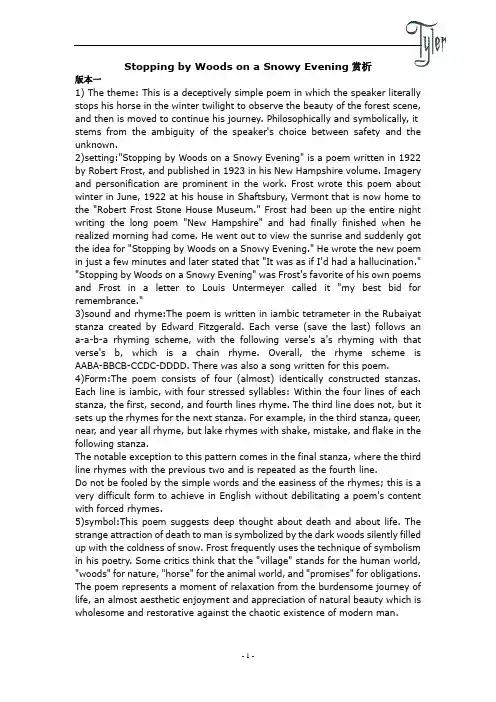
Stopping by Woods on a Snowy Evening赏析版本一1) The theme: This is a deceptively simple poem in which the speaker literally stops his horse in the winter twilight to observe the beauty of the forest scene, and then is moved to continue his journey. Philosophically and symbolically, it stems from the ambiguity of the speaker's choice between safety and the unknown.2)setting:"Stopping by Woods on a Snowy Evening" is a poem written in 1922 by Robert Frost, and published in 1923 in his New Hampshire volume. Imagery and personification are prominent in the work. Frost wrote this poem about winter in June, 1922 at his house in Shaftsbury, Vermont that is now home to the "Robert Frost Stone House Museum." Frost had been up the entire night writing the long poem "New Hampshire" and had finally finished when he realized morning had come. He went out to view the sunrise and suddenly got the idea for "Stopping by Woods on a Snowy Evening." He wrote the new poem in just a few minutes and later stated that "It was as if I'd had a hallucination." "Stopping by Woods on a Snowy Evening" was Frost's favorite of his own poems and Frost in a letter to Louis Untermeyer called it "my best bid for remembrance."3)sound and rhyme:The poem is written in iambic tetrameter in the Rubaiyat stanza created by Edward Fitzgerald. Each verse (save the last) follows an a-a-b-a rhyming scheme, with the following verse's a's rhyming with that verse's b, which is a chain rhyme. Overall, the rhyme scheme is AABA-BBCB-CCDC-DDDD. There was also a song written for this poem.4)Form:The poem consists of four (almost) identically constructed stanzas. Each line is iambic, with four stressed syllables: Within the four lines of each stanza, the first, second, and fourth lines rhyme. The third line does not, but it sets up the rhymes for the next stanza. For example, in the third stanza, queer, near, and year all rhyme, but lake rhymes with shake, mistake, and flake in the following stanza.The notable exception to this pattern comes in the final stanza, where the third line rhymes with the previous two and is repeated as the fourth line.Do not be fooled by the simple words and the easiness of the rhymes; this is a very difficult form to achieve in English without debilitating a poem's content with forced rhymes.5)symbol:This poem suggests deep thought about death and about life. The strange attraction of death to man is symbolized by the dark woods silently filled up with the coldness of snow. Frost frequently uses the technique of symbolism in his poetry. Some critics think that the "village" stands for the human world, "woods" for nature, "horse" for the animal world, and "promises" for obligations. The poem represents a moment of relaxation from the burdensome journey of life, an almost aesthetic enjoyment and appreciation of natural beauty which is wholesome and restorative against the chaotic existence of modern man.版本二Summary:On the surface, this poem is simplicity itself. The speaker is stopping by some woods on a snowy evening. He or she takes in the lovely scene in near-silence, is tempted to stay longer, but acknowledges the pull of obligations and the considerable distance yet to be traveled before he or she can rest for the night. Form:The poem consists of four (almost) identically constructed stanzas. Each line is iambic, with four stressed syllables:Within the four lines of each stanza, the first, second, and fourth lines rhyme. The third line does not, but it sets up the rhymes for the next stanza. For example, in the third stanza, queer, near, and year all rhyme, but lake rhymes with shake, mistake, and flake in the following stanza.The notable exception to this pattern comes in the final stanza, where the third line rhymes with the previous two and is repeated as the fourth line.Do not be fooled by the simple words and the easiness of the rhymes; this is a very difficult form to achieve in English without debilitating a poem's content with forced rhymes.Commentary:This is a poem to be marveled at and taken for granted. Like a big stone, like a body of water, like a strong economy, however it was forged it seems that, once made, it has always been there. Frost claimed that he wrote it in a single nighttime sitting; it just came to him. Perhaps one hot, sustained burst is the only way to cast such a complete object, in which form and content, shape and meaning, are alloyed inextricably. One is tempted to read it, nod quietly in recognition of its splendor and multivalent meaning, and just move on. But one must write essays. Or study guides.Like the woods it describes, the poem is lovely but entices us with dark depths--of interpretation, in this case. It stands alone and beautiful, the account of a man stopping by woods on a snowy evening, but gives us a come-hither look that begs us to load it with a full inventory of possible meanings. We protest, we make apologies, we point to the dangers of reading poetry in this way, but unlike the speaker of the poem, we cannot resist.The last two lines are the true culprits. They make a strong claim to be the most celebrated instance of repetition in English poetry. The first "And miles to gobefore I sleep" stays within the boundaries of literalness set forth by the rest of the poem. We may suspect, as we have up to this point, that the poem implies more than it says outright, but we can't insist on it; the poem has gone by so fast, and seemed so straightforward. Then comes the second "And miles to go before I sleep," like a soft yet penetrating gong; it can be neither ignored nor forgotten. The sound it makes is "Ahhh." And we must read the verses again and again and offer trenchant remarks and explain the "Ahhh" in words far inferior to the poem. For the last "miles to go" now seems like life; the last "sleep" now seems like death.The basic conflict in the poem, resolved in the last stanza, is between an attraction toward the woods and the pull of responsibility outside of the woods. What do woods represent? Something good? Something bad? Woods are sometimes a symbol for wildness, madness, the pre-rational, the looming irrational. But these woods do not seem particularly wild. They are someone's woods, someone's in particular--the owner lives in the village. But that owner is in the village on this, the darkest evening of the year--so would any sensible person be. That is where the division seems to lie, between the village (or "society," "civilization," "duty," "sensibility," "responsibility") and the woods (that which is beyond the borders of the village and all it represents). If the woods are not particularly wicked, they still possess the seed of the irrational; and they are, at night, dark--with all the varied connotations of darkness.Part of what is irrational about the woods is their attraction. They are restful, seductive, lovely, dark, and deep--like deep sleep, like oblivion. Snow falls in downy flakes, like a blanket to lie under and be covered by. And here is where many readers hear dark undertones to this lyric. To rest too long while snow falls could be to lose one's way, to lose the path, to freeze and die. Does this poem express a death wish, considered and then discarded? Do the woods sing a siren's song? To be lulled to sleep could be truly dangerous. Is allowing oneself to be lulled akin to giving up the struggle of prudence and self-preservation? Or does the poem merely describe the temptation to sit and watch beauty while responsibilities are forgotten--to succumb to a mood for a while?The woods sit on the edge of civilization; one way or another, they draw the speaker away from it (and its promises, its good sense). "Society" would condemn stopping here in the dark, in the snow--it is ill advised. The speaker ascribes society's reproach to the horse, which may seem, at first, a bit odd. But the horse is a domesticated part of the civilized order of things; it is the nearest thing to society's agent at this place and time. And having the horse reprove the speaker (even if only in the speaker's imagination) helps highlight several uniquely human features of the speaker's dilemma. One is the regard for beauty(often flying in the face of practical concern or the survival instinct); another is the attraction to danger, the unknown, the dark mystery; and the third--perhaps related but distinct--is the possibility of the death wish, of suicide.Not that we must return too often to that darkest interpretation of the poem. Beauty alone is a sufficient siren; a sufficient protection against her seduction is an unwillingness to give up on society despite the responsibilities it imposes. The line "And miles to go before I sleep" need not imply burden alone; perhaps the ride home will be lovely, too. Indeed, the line could be read as referring to Frost's career as a poet, and at this time he had plenty of good poems left in him.。
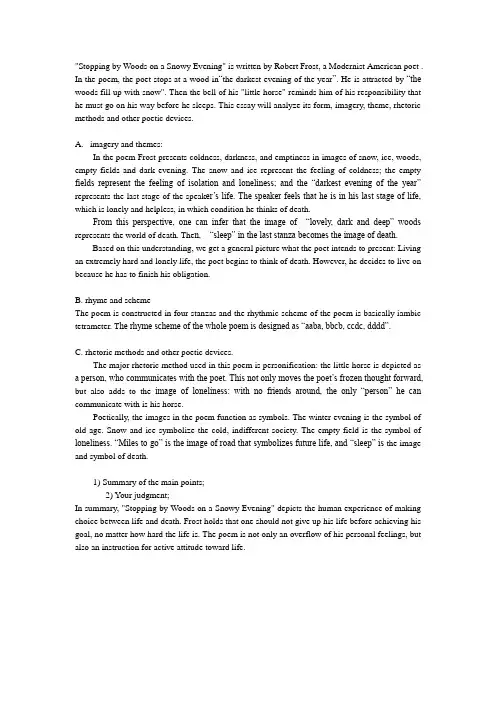
"Stopping by Woods on a Snowy Evening" is written by Robert Frost, a Modernist American poet . In the poem, the poet stops at a wood in“the darkest evening of the year”. He is attracted by “the woods fill up with snow". Then the bell of his "little horse" reminds him of his responsibility that he must go on his way before he sleeps. This essay will analyze its form, imagery, theme, rhetoric methods and other poetic devices.A.imagery and themes:In the poem Frost presents coldness, darkness, and emptiness in images of snow, ice, woods, empty fields and dark evening. The snow and ice represent the feeling of coldness; the empty fields represent the feeling of isolation and loneliness; and the “darkest evening of the year” represents the last stage of the speak er’s life. The speaker feels that he is in his last stage of life, which is lonely and helpless, in which condition he thinks of death.From this perspective, one can infer that the image of “lovely, dark and deep” woods represents the world of death. The n, “sleep” in the last stanza becomes the image of death.Based on this understanding, we get a general picture what the poet intends to present: Living an extremely hard and lonely life, the poet begins to think of death. However, he decides to live on because he has to finish his obligation.B. rhyme and schemeThe poem is constructed in four stanzas and the rhythmic scheme of the poem is basically iambic tetrameter. T he rhyme scheme of the whole poem is designed as “aaba, bbcb, ccdc, dddd”.C. rhetoric methods and other poetic devices.The major rhetoric method used in this poem is personification: the little horse is depicted as a person, who communicates with the poet. This not only moves the poet’s frozen thought forward, but also adds to the image of loneliness: with no friends around, the only “person” he can communicate with is his horse.Poetically, the images in the poem function as symbols. The winter evening is the symbol of old age. Snow and ice symbolize the cold, indifferent society. The empty field is the symbol of loneliness. “Miles to go” is the image of road that symbolizes future life, and “sleep” is the image and symbol of death.1) Summary of the main points;2) Your judgment;In summary, "Stopping by Woods on a Snowy Evening" depicts the human experience of making choice between life and death. Frost holds that one should not give up his life before achieving his goal, no matter how hard the life is. The poem is not only an overflow of his personal feelings, but also an instruction for active attitude toward life.。
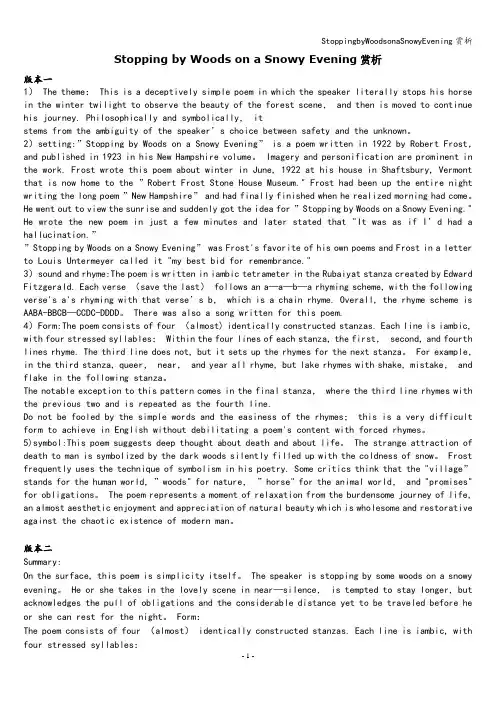
Stopping by Woods on a Snowy Evening赏析版本一1) The theme: This is a deceptively simple poem in which the speaker literally stops his horse in the winter twilight to observe the beauty of the forest scene, and then is moved to continue his journey. Philosophically and symbolically, itstems from the ambiguity of the speaker’s choice between safety and the unknown。
2)setting:”Stopping by Woods on a Snowy Evening” is a poem written in 1922 by Robert Frost,and published in 1923 in his New Hampshire volume。
Imagery and personification are prominent in the work. Frost wrote this poem about winter in June, 1922 at his house in Shaftsbury, Vermont that is now home to the ”Robert Frost Stone House Museum." Frost had been up the entire night writing the long poem ”New Hampshire” and had finally finished when he realized morning had come。
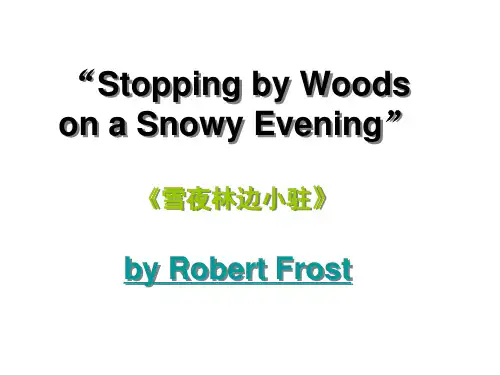
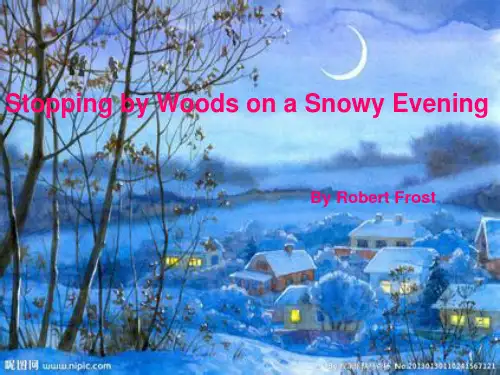
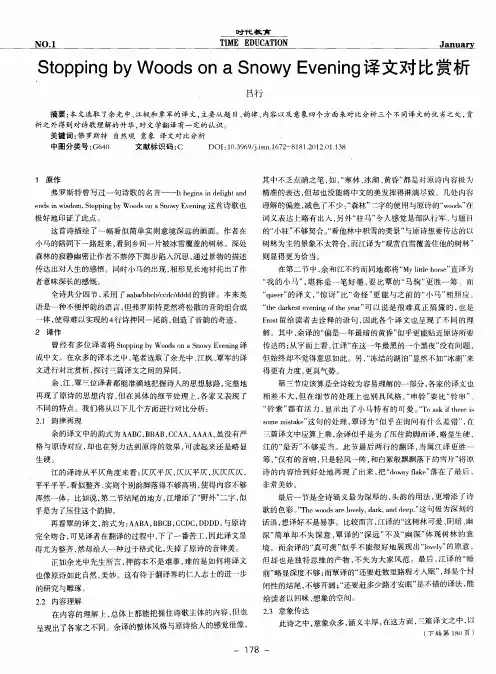
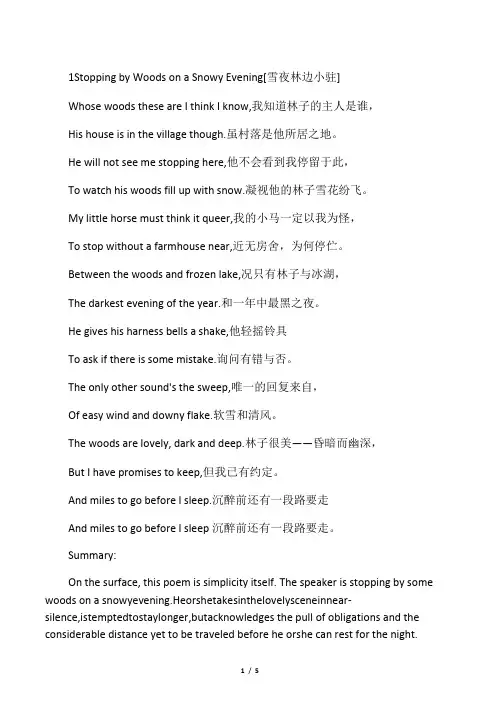
1Stopping by Woods on a Snowy Evening[雪夜林边小驻]Whose woods these are I think I know,我知道林子的主人是谁,His house is in the village though.虽村落是他所居之地。
He will not see me stopping here,他不会看到我停留于此,To watch his woods fill up with snow.凝视他的林子雪花纷飞。
My little horse must think it queer,我的小马一定以我为怪,To stop without a farmhouse near,近无房舍,为何停伫。
Between the woods and frozen lake,况只有林子与冰湖,The darkest evening of the year.和一年中最黑之夜。
He gives his harness bells a shake,他轻摇铃具To ask if there is some mistake.询问有错与否。
The only other sound's the sweep,唯一的回复来自,Of easy wind and downy flake.软雪和清风。
The woods are lovely, dark and deep.林子很美——昏暗而幽深,But I have promises to keep,但我已有约定。
And miles to go before I sleep.沉醉前还有一段路要走And miles to go before I sleep沉醉前还有一段路要走。
Summary:On the surface, this poem is simplicity itself. The speaker is stopping by some woods on a snowyevening.Heorshetakesinthelovelysceneinnear-silence,istemptedtostaylonger,butacknowledges the pull of obligations and the considerable distance yet to be traveled before he orshe can rest for the night.Form:The poem consists of four (almost) identically constructed stanzas. Each line is iambic, with fourstressed syllables:Do not be fooled by the simple words and the easiness of the rhymes; this is a very difficult formto achieve in English without debilitating a poem's content with forced rhymes.Commentary:Thebasicconflictinthepoem,resolvedinthelastanza,isbetweenattractiontowardthewoo ds and the pull of responsibility outside of the woods. What do woods represent? Somethinggood? Something bad? Woods are sometimes a symbol for wildness, madness, the pre-rational,theloomingirrational.Butthesewoodsdonotseemparticularlywild.Theyaresomeone'sw oods,someone's in particular--the owner lives in the village. But that owner is in the village on this, thedarkest evening of the year--so would any sensible person be. That is where the division seems tolie, between the village (or "society," "civilization," "duty," "sensibility," "responsibility") and thewoods (that which is beyond the borders of the village and all it represents). If the woods are notparticularly wicked, they still possess the seed of the irrational; and they are, at night, dark--withall the varied connotations of darkness.Part of what is irrational about the woods is their attraction. They are restful, seductive, lovely,dark,anddeep--likedeepsleep,likeoblivion.Snowfallsindownyflakes,likeablankettolieunder and be covered by. And here is where many readers hear dark undertones to this lyric. Torest too long while snow falls could be to lose one's way, to lose the path, to freeze and die. Doesthis poem express a death wish, considered and then discarded? Do the woods sing a siren's song?To be lulled to sleep could be truly dangerous. Is allowing oneself to be lulled akin to giving upthe struggle of prudence and self-preservation? Or does the poemmerely describe the temptationto sit and watch beauty while responsibilities are forgotten--to succumb to a mood for a while?The woods sit on the edge of civilization; one way or another, they draw the speaker away fromit(anditspromises,itsgoodsense)."Society"wouldcondemnstoppinghereinthedark,inth esnow--it is ill advised. The speaker ascribes society's reproach to the horse, which may seem, atfirst, a bit odd. But the horse is a domesticated part of the civilized order of things; it is the nearestthing to society's agent at this place and time. And having the horse reprove the speaker (even ifonly in the speaker's imagination) helps highlight several uniquely human features of the speaker'sdilemma. One is the regard for beauty (often flying in the face of practical concern or the survivalinstinct); another is the attraction to danger, the unknown, the dark mystery; and the third--perhapsrelated but distinct--is the possibility of the death wish, of suicide.Notthatwemustreturntoooftentothatdarkestinterpretationofthepoem.Beautyalo neisasufficientsiren;asufficientprotectionagainstherseductionisanunwillingnesstogive uponsociety despite the responsibilities it imposes. The line "And miles to go before I sleep" need notimply burden alone; perhaps the ride home will be lovely, too. Indeed, the line could be read asreferring to Frost's career as a poet, and at this time he had plenty of good poems left in him.2This poem is written by the American poet Robert Frost whose works are mostly concerned withnature. In this poem, he describes a little incident happening in a snowy evening. As a traveler, thepoet is fascinated by the beautiful scene in the woods. He stops to enjoy it, but his mind urges himto go on, because there is still a long way ahead of him, an unfinished duty waiting for him. Thispoemisplainwords,butprofoundinmeaning.Sinceitisfullofsymbolicconstructs,itisth ought- provoking, and the readers can get great fun in developing the subtext.In the first stanza, the poet leads us to a piece of beautiful woods filled up with snow. Asweallknowthatthewoodsareusuallylinkedwithmyth,theunknownworld,andtheutmostt ranquillity. We can guess that, in this poem, the poet takes the woods as the eternal life, thebliss,thatistosaytheHeaven.Heisfedupwitheroutineduties,andwantstorestforever.The woods happens to provide an ideal place.In the third stanza, the little horse wonders why the poet stops when he should have go on.Only “the easy wind” and “downy flake” answer it with soft sweep. We can imagin the scene:the“downy flake” is so light and gentle that it flies in the soft wind. Thus we can get the idea:thepoet’s answer is as slight and uncertain as theflakes, because he himself doesn’tknow why hestops suddenly in the woods.In this poem, Robert Frost discusses the relation between mortal obligations and the eternalrest. One leaves no regrets after he dies, as long as one has reached his goal.3In the poem,“Stopping by Woods on a Snowy Evening,” the speaker stops by some woods ona snowy evening and absorbs the lovely scene. The speaker is tempted to stay longer, butThe poem consists of four almost identically constructed quatrains. Each line has iambictetrameter. Within the four lines of each stanza, the first, second, and fourth lines rhyme. Thethird line does not, but it sets up the rhymes for the next stanza. The rhyme scheme is asfollows:a,a,b,a;b,b,c,b. For example, in the second stanza, lines five through eight, queer,near, and year all rhyme, but lake rhymes with shake, mistake, and flake in the followingstanza. The only exception is the last stanza in which the third line rhymes with the previoustwo lines and is repeated as the fourth line, therefore the rhyme scheme:d,d,d,d.depression or loneliness. The third stanza of the poem brings the strangeness of the situationto a head. The only other living being in this cold lonely landscape, the speaker's horse takesaction to find the reason for the odd stopping. The noise from the inquisitive harness bellsprovide contrast to the quiet of the scene, where the only other sounds a wind and snow. Thedescriptions of the sounds provide a little insightto the speaker's mindset and position. He is sostill that he can here the soft fall of the downy flake and hear the movement of the easy wind.This also shows a great calm and patience that the speaker must posses. The final stanza of thepoem brings all the sentiments of the poem together, an intense love and awe of nature, anever ending patience and some unknown task or problem that robs the speaker of rest. Thedark and deep woods seem to reflect the speaker, his dark emotion and depth of character.There stillness also contrasts with the need of the repeated closing lines And miles to go beforeI sleep/ And miles to go before I sleep. These final lines represent the problem that has plaguedthe speaker and that is most likely responsible for his dark mood. It is something that isundefined that does not demand a rush to deal with, but is important enough to demandattention. The poem as a whole, is a simple effigy of a quiet thoughtful night. I can easily relateto the poem, the emotions it describes and the way that the images are presented. The carelessease with which the poem is read is vital to the poem as a whole. Also this is my favorite poem,I didn't have to open the book to rember it, only to see its format again. It reminds me of themoods I feel on snowy nights or early mornings. I live in the woods and before I drove; I oftenwalked through them as a shortcut to visit friends, so I have many memories of stopping by aneighbors wood on an easy walk home, and watching the snow slowly fall.。
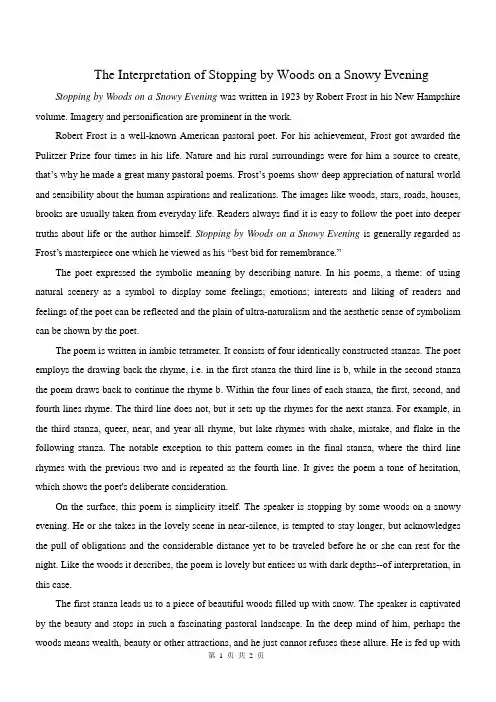
The Interpretation of Stopping by Woods on a Snowy Evening Stopping by Woods on a Snowy Evening was written in 1923 by Robert Frost in his New Hampshire volume. Imagery and personification are prominent in the work.Robert Frost is a well-known American pastoral poet. For his achievement, Frost got awarded the Pulitzer Prize four times in his life. Nature and his rural surroundings were for him a source to create, that’s why he made a great many pastoral poems. Frost’s poems show deep appreciation of natural world and sensibility about the human aspirations and realizations. The images like woods, stars, roads, houses, brooks are usually taken from everyday life. Readers always find it is easy to follow the poet into deeper truths about life or the author himself. Stopping by Woods on a Snowy Evening is generally regarded as Frost’s masterpiece one which he viewed a s his “best bid for remembrance.”The poet expressed the symbolic meaning by describing nature. In his poems, a theme: of using natural scenery as a symbol to display some feelings; emotions; interests and liking of readers and feelings of the poet can be reflected and the plain of ultra-naturalism and the aesthetic sense of symbolism can be shown by the poet.The poem is written in iambic tetrameter. It consists of four identically constructed stanzas. The poet employs the drawing back the rhyme, i.e. in the first stanza the third line is b, while in the second stanza the poem draws back to continue the rhyme b. Within the four lines of each stanza, the first, second, and fourth lines rhyme. The third line does not, but it sets up the rhymes for the next stanza. For example, in the third stanza, queer, near, and year all rhyme, but lake rhymes with shake, mistake, and flake in the following stanza. The notable exception to this pattern comes in the final stanza, where the third line rhymes with the previous two and is repeated as the fourth line. It gives the poem a tone of hesitation, which shows the poet's deliberate consideration.On the surface, this poem is simplicity itself. The speaker is stopping by some woods on a snowy evening. He or she takes in the lovely scene in near-silence, is tempted to stay longer, but acknowledges the pull of obligations and the considerable distance yet to be traveled before he or she can rest for the night. Like the woods it describes, the poem is lovely but entices us with dark depths--of interpretation, in this case.The first stanza leads us to a piece of beautiful woods filled up with snow. The speaker is captivated by the beauty and stops in such a fascinating pastoral landscape. In the deep mind of him, perhaps the woods means wealth, beauty or other attractions, and he just cannot refuses these allure. He is fed up withthe routine duties, and wants to rest forever. The woods happens to provide an ideal place. The second stanza depicts the surro undings of the woods through the speaker’s little horse’s eye.“The darkest evening of the year” tell us that the snow is cold and the evening dark, all of which indicate that the poet is depressed inside. And now is the darkest time of the sp eaker’s life, so when he meets the good views in the traveling, he couldn’t help to enjoying the world of fair allure and loneliness. In the third stanza, the little horse wonders why the poet stops when he should have go on. He cannot understand why the speaker—his owner stops there and gazes at the woods. The extreme quietness actually reflects the speaker’s confusing mind. The little horse actually represents another self of speaker and the two speakers have the conversation in heart to decide what he should do. The last stanza is the speaker’s decision and conclusive idea. Finally, the speaker makes his mind to go back to the world with responsibilities. “The promise” could be an obligation or a goal. It represents responsibilities in the human world. The last two repeated lines emphasize the speaker’s determination and he has to keep all the promises and takes the responsibilities. “Sleep” means death, the end of one’s life. The speaker has to deal with chores and promises in the rest of his life.In this poem, Robert Frost gives the effect of sighting. The narrator wants to rest but he cannot, and the horse is reminding him to come back. And he discusses the relation between mortal obligations and the eternal rest. One leaves no regrets after he dies, as long as one has reached his goal. The speaker is tempted toward death which he considers “love,dark and deep”.。
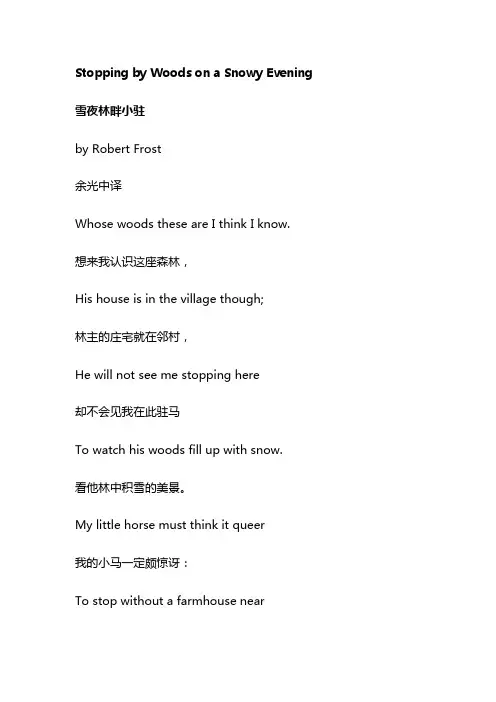
Stopping by Woods on a Snowy Evening 雪夜林畔小驻by Robert Frost余光中译Whose woods these are I think I know.想来我认识这座森林,His house is in the village though;林主的庄宅就在邻村,He will not see me stopping here却不会见我在此驻马To watch his woods fill up with snow.看他林中积雪的美景。
My little horse must think it queer我的小马一定颇惊讶:To stop without a farmhouse near四望不见有什么农家,Between the woods and frozen lake 偏是一年最暗的黄昏,The darkest evening of the year.寒林和冰湖之间停下。
He gives his harness bells a shake它摇一摇身上的串铃To ask if there is some mistake.问我这地方该不该停。
The only other sound’s the sweep 此外只有轻风拂雪片,Of easy wind and downy flake.再也听不见其他声音。
The woods are lovely, dark and deep, 森林又暗又深真可羡,But I have promises to keep,但我还要守一些诺言,And miles to go before I sleep,还要赶多少路才安眠,And miles to go before I sleep.还要赶多少路才安眠。
全诗用简单质朴的语言讲述了一个夜行的旅者在树林边驻足欣赏大雪纷飞的景象,尽管旅人认为风景很美,但他还是决定继续赶路,但其实全诗紧密围绕“人生即旅途”这一核心层层铺展开来。

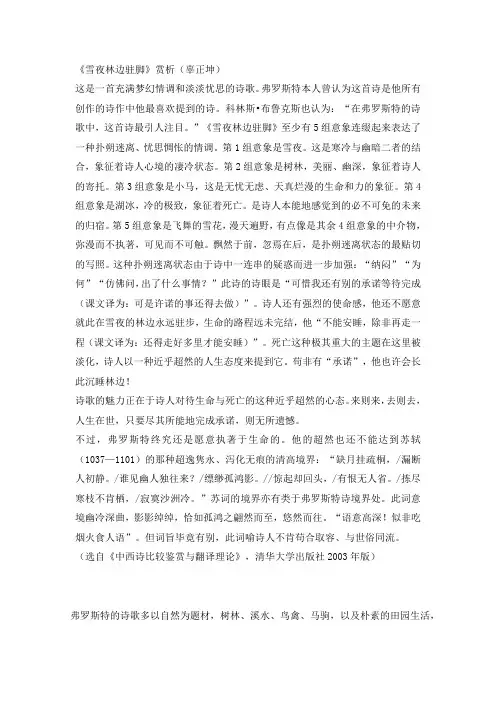
《雪夜林边驻脚》赏析(辜正坤)这是一首充满梦幻情调和淡淡忧思的诗歌。
弗罗斯特本人曾认为这首诗是他所有创作的诗作中他最喜欢提到的诗。
科林斯•布鲁克斯也认为:“在弗罗斯特的诗歌中,这首诗最引人注目。
”《雪夜林边驻脚》至少有5组意象连缀起来表达了一种扑朔迷离、忧思惆怅的情调。
第1组意象是雪夜。
这是寒冷与幽暗二者的结合,象征着诗人心境的凄冷状态。
第2组意象是树林,美丽、幽深,象征着诗人的寄托。
第3组意象是小马,这是无忧无虑、天真烂漫的生命和力的象征。
第4组意象是湖冰,冷的极致,象征着死亡。
是诗人本能地感觉到的必不可免的未来的归宿。
第5组意象是飞舞的雪花,漫天遍野,有点像是其余4组意象的中介物,弥漫而不执著,可见而不可触。
飘然于前,忽焉在后,是扑朔迷离状态的最贴切的写照。
这种扑朔迷离状态由于诗中一连串的疑惑而进一步加强:“纳闷”“为何”“仿佛问,出了什么事情?”此诗的诗眼是“可惜我还有别的承诺等待完成(课文译为:可是许诺的事还得去做)”。
诗人还有强烈的使命感,他还不愿意就此在雪夜的林边永远驻步,生命的路程远未完结,他“不能安睡,除非再走一程(课文译为:还得走好多里才能安睡)”。
死亡这种极其重大的主题在这里被淡化,诗人以一种近乎超然的人生态度来提到它。
苟非有“承诺”,他也许会长此沉睡林边!诗歌的魅力正在于诗人对待生命与死亡的这种近乎超然的心态。
来则来,去则去,人生在世,只要尽其所能地完成承诺,则无所遗憾。
不过,弗罗斯特终究还是愿意执著于生命的。
他的超然也还不能达到苏轼(1037—1101)的那种超逸隽永、泻化无痕的清高境界:“缺月挂疏桐,/漏断人初静。
/谁见幽人独往来?/缥缈孤鸿影。
//惊起却回头,/有恨无人省。
/拣尽寒枝不肯栖,/寂寞沙洲冷。
”苏词的境界亦有类于弗罗斯特诗境界处。
此词意境幽冷深曲,影影绰绰,恰如孤鸿之翩然而至,悠然而往。
“语意高深!似非吃烟火食人语”。
但词旨毕竟有别,此词喻诗人不肯苟合取容、与世俗同流。
初二英语诗歌之魂阅读理解20题1<背景文章>Poetry has the power to touch our hearts and souls. One classic English poem that showcases this power is "Stopping by Woods on a Snowy Evening" by Robert Frost.This poem is rich in themes, imagery, and emotional expression. The theme revolves around the beauty and tranquility of nature, as well as the poet's inner conflict and sense of responsibility. The imagery is vivid, with descriptions of snowy woods, a frozen lake, and a horse that seems to understand the poet's hesitation. The emotional tone is one of wonder, longing, and a touch of melancholy.The poem begins with the line "Whose woods these are I think I know." This immediately sets a tone of mystery and curiosity. As the poet continues to describe the woods and the snow, we are drawn into a world of peace and stillness. However, there is also a sense of unease as the poet realizes he has promises to keep and miles to go before he sleeps.This poem is a masterpiece of English literature, and its beauty lies in its simplicity and depth. It invites us to pause and reflect on the beauty of nature and our own place in the world.1. What is the main theme of the poem "Stopping by Woods on aSnowy Evening"?A. Adventure and excitement.B. Love and romance.C. The beauty and tranquility of nature, and the poet's inner conflict.D. War and destruction.答案:C。
经典咏流传的英语诗歌朗诵的英语作文Stepping onto the stage, the spotlight illuminated the pages of the book held tightly in my hands. The audience fell silent, their anticipation palpable. It was not just another performance; it was a bridge to the past, a dialogue with the masters of words whose echoes have reverberated through centuries. This was my moment to breathe life into the verses of classic English poetry.My selection for the evening was “Stopping by Woods on a Snowy Evening” by Robert Frost, a poem that encapsu lates the timeless appeal of simplicity and the human condition. As I began to recite, each word was a brushstroke painting a scene of serenity and introspection. The audience was transported to a snowy woods, the speaker pausing to admire the beauty around him, despite the obligations that call him onward. The final lines, “And miles to go before I sleep,” resonated with a poignant truth about life’s journey and the inevitable end that awaits us all.Following Frost, I moved on to the passionate rhythms of William Wordsworth’s “I Wandered Lonely as a Cloud.” This poem, often referred to as “Daffodils,” celebrated the joy found in nature’s simplest beauties. Reciting the lines, “Continuous as the stars that shine / And twinkle on the Milky Way,” I felt the e nergy of thedaffodils dancing in the breeze, their golden heads swaying in harmony. The imagery evoked a sense of peace and a reminder that happiness can be found in the most unexpected places.Each poem was a voyage through the mind of its creator, a glimpse into the soul of an era long gone. Reciting them was like holding a conversation with the poets themselves, feeling their emotions, and understanding their perspectives. It was a humbling experience, a privilege to give voice to words that have stood the test of time.The impact of classic poetry recitation extends beyond the immediate performance. It fosters a deeper appreciation for the English language, enriches vocabulary, and enhances public speaking skills. More importantly, it cultivates a connection with the human experience, allowing us to see through the eyes of others and empathize with their joys, sorrows, and reflections.In conclusion, participating in the recitation of classic English poems is not merely an artistic endeavor; it is a journey through time, a celebration of language, and a connection to the universal human spirit that transcends generations.。
关于冬天的英语诗歌冬日里的一切是那么的美好.你知道关于冬天的英文诗歌有哪些嘛?下面是小编为大家整理收集的关于冬天的英文诗歌,欢迎大家阅读!关于冬天的英文诗歌一Stopping by Woods on a Snowy EveningBy Robert FrostWhose woods these are I think I know.His house is in the village though;He will not see me stopping hereTo watch his woods fill up with snow.My little horse must think it queerTo stop without a farmhouse nearBetween the woods and frozen lakeThe darkest evening of the year.He gives his harness bells a shakeTo ask if there is some mistake.The only other sound's the sweepOf easy wind and downy flake.The woods are lovely, dark and deep.But I have promises to keep,And miles to go before I sleep,And miles to go before I sleep.雪夜林畔驻马罗伯特.弗罗斯特我想我知道这是谁的树林.他的家虽在那边乡村;他看不到我驻足在此地,伫望他的树林白雪无垠.我的小马一定会觉得离奇,停留于旷无农舍之地,在这树林和冰湖中间一年中最昏暗的冬夕.它将它的佩铃朗朗一牵问我有没有弄错了地点.此外但闻微风的拂吹和纷如鹅毛的雪片这树林真可爱,黝黑而深邃.可是我还要赶好几英里路才能安睡, 还要赶好几英里才能安睡.关于冬天的英文诗歌二Flower of Winter, Flower of Spring A Flower bloomsIn winter’s chi llThough Darkness loomsIt remains still.Throughout the stormsOf snow and hailThe Flower formsIts figure frailThen springtime dawnsAnd on the groundFlower is not goneThough others aboundA young man seesThe flowers swayWith gentle breezeHe walks their wayAnd for his maidenpicks one out Nature’s game played Without a doubtA Flower pickedFor lovers’ willA Flower bornIn winter’s chill翻译:冬花,春天花阿开花在冬天的寒意虽然黑暗织机它仍然还是。
《雪夜林畔小憩》(“Stopping by Woods on a Snowy Evening”)是美国诗人Robert Frost的作品,被认为是现代英语的短篇杰作。
此诗之难能可贵,在于意境含蓄,用语天然,格律严谨,貌似写景,却别有寓意。
Stopping by Woods on a Snowy Evening 雪夜林畔小憩Whose woods these are I think I know. 想来我认识这片树林,His house is in the village though; 尽管林主就住在邻村;He will not see me stopping here 却不会见我在此驻马,To watch his woods fill up with snow. 赏他林中漫天雪纷纷。
My little horse must think it queer 我的小马一定很惊讶:To stop without a farmhouse near 不见有农家为何停下,Between the woods and frozen lake 偏在寒林和冰湖中间,The darkest evening of the year. 还是一年中最暗傍晚。
He gives his harness bells a shake 小马摇摇身上的铃串,To ask if there is some mistake. 想问我是否又把错犯。
The only other sound’s the sweep 唯一能够听到的声音,Of easy wind and downy flake. 来自轻风和漫天雪片。
The woods are lovely, dark, and deep, 树林很美很暗很幽深,But I have promises to keep, 我虽神往但有约在先,And miles to go before I sleep, 要赶多少路才能安眠,And miles to go before I sleep. 要赶多少路才能安眠。
2024年上海初三物理一模汇编:动态电路1、(2024崇明一模)“热敏电阻”控制型动态电路如图1所示的电路,电源电压不变,R 1为热敏电阻,其阻值随温度的升高而减小.闭合开关S ,当监控区的温度升高时,电流表和电压表示数变化的情况是A .电流表示数变大,电压表示数变大B .电流表示数变小,电压表示数变小C .电流表示数变大,电压表示数变小D .电流表示数变小,电压表示数变大2、(2024徐汇一模)图6为烟雾报警器的模拟电路, R 1是滑动变阻器,R c 是气敏电阻,其阻值会随烟雾浓度增大而减小。
当烟雾浓度C 达到8%,电压表示数小于U 0时就会报警。
若要增大该装置对烟雾探测的灵敏度,即烟雾浓度C 达到4%时就报警,下列方案中可行的是 A .增大电源电压 B .向右移动滑片PC .增大电源电压,向右移动滑片PD .减小电源电压,向右移动滑片P3、(2024长宁一模)在图1所示的电路中,电源电压保持不变,电阻R 1、R 2均为定值电阻。
若在电路中添加一个电压表,闭合开关S 前后,发现电压表与电流表示数的比值不变,则电压表并联的位置 A .只能是MN 两点间 B .可能是PN 两点间 C .只能是MQ 两点间 D .可能是PM 两点间4、(2024黄浦一模)在图2所示的电路中,闭合开关S ,电路正常工作。
现对电路分别进行下列操作:①将滑动变阻器滑片向左移;②用电阻R 3(R 3>R 1)替换电阻R 1;③断开开关S ;④增大电源电压。
其中能使电压表示数变大的操作有 A .1个 B .2个 C .3个D .4个图1R 1 R 2VAS监控区 R 1S图6R C V P SR 1 R 2A图1NPMQ图2 VSR 1R 2P5、(2024宝山一模)如图7所示电路,滑动变阻器R 2的滑片P 向右移动时,判断电表的示数变化情况。
小宝同学的分析如下:①滑动变阻器的阻值变大→②电路的总电阻变大→③电流表A 的示数变小→④电压表V 的示数变大。
【Stopping by Woods on a Snowy Evening】1、Why did the horse give the harness bell a shake?It is a personification. As the speaker tells us in the second stanza, the horse shakes its bell to remind him of going on his journey. The horse is very curious about it since it is used to following a routine to reach its purpose or destination. This indicates that the speaker at first does not intend to stop by the woods. Therefore, he is in effect asking himself his motivation by imagining the horse is questioning.2、Why couldn't the speaker stay longer by the woods to appreciate its mysterious beauty?In the last stanza, the speaker says he has promises to keep. It is telling us the reason why he can not stay longer to appreciate the beauty. Therefore, we can easily understand that it is social responsibility, personal commitment and missions that bring him back to the real world and force him to go on his journey.3、What's the effect of repetition in the last two lines of the poem?From the repetition in the last two lines, the speaker wants to remind the reader a simple fact of life: whatever happens, one must go forward in the journey of life. And he is aimed at emphasizing the long way one must cover before the end of life.4、Analyze the form of this poem.This poem consists of four stanzas, each containing four lines of iambic meter. The first three stanzas rhyme in "aaba", whereas the last stanza rhymes in a consistent "c" which brings the poem to a harmonious end. The language of the poem is simple.【Mending Wall】1、What is the attitude of the speaker and his neighbor toward the wall? Apparently, the speaker and his neighbor hold totally different view toward the wall. The speaker believes that there is no necessary to build a wall because they grow different crops and there is no cow in both yards. However, his neighbor argues that “Good fences make good neighbors” and there should be a wall between them.2、What does the speaker think of the neighbor’s attitude?In the speaker’s eyes, his neighbor is a stubborn man who could not make changes according to the current situations. By comparing the two opposite attitudes, we can learn that the neighbor stands for those who are unable to accept new things, while the speaker is the representative of those who is willing to innovate and communicate with others.【The Road Not Taken】1、Why does the speaker choose the road less traveled by?In the second stanza, the speaker says that either road is ok and says that the road less traveled by is grassy and needs treading. We can learn that speaker chooses the one less traveled by because he does not want to follow other people's pace. He holds the belief that it is the road one chooses that makes the man who he is. Here, the speaker shows his willingness to make a difference in his life.2、What’s the speaker’s initial response to the divergence of the two roads?From the first stanza, the speaker feels sorry because he can not try both at one time. Therefore, he is reduced into a state of dilemma. Before he makes the final decision, he looks down on both roads as far as possible.3、What might the two roads stand for on the speaker’s mind?Life is a journey filled with choices. Here the speaker arrives at a divergence of life. He uses the road chose by average people to symbolize a safe and straightforward way to reach one’s purpose. And the other road less traveled by is used to represent a relatively new and risky method to realize one's target.Reach one’s purposeachieve one's goalrealize one's target。